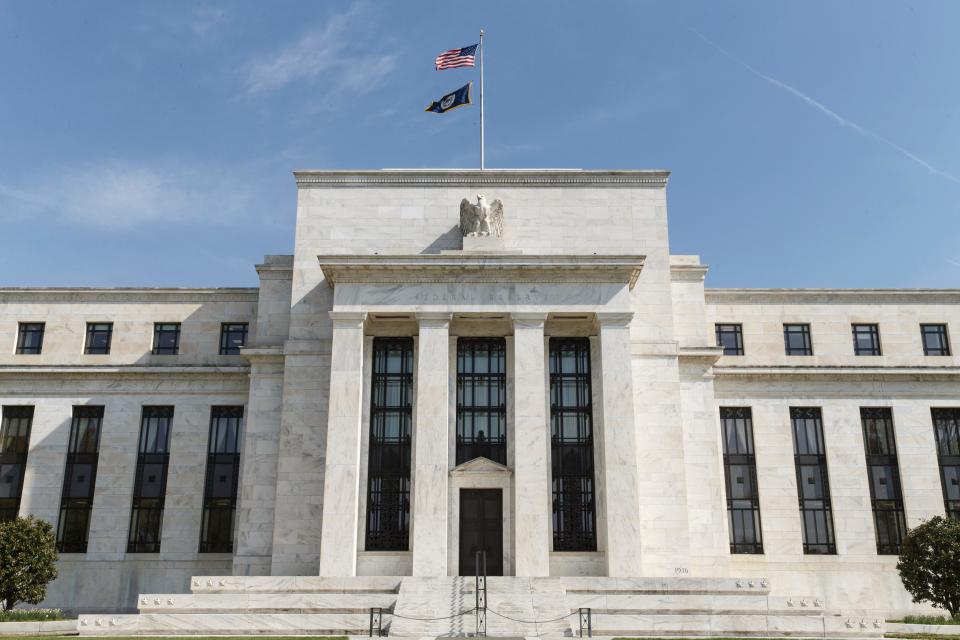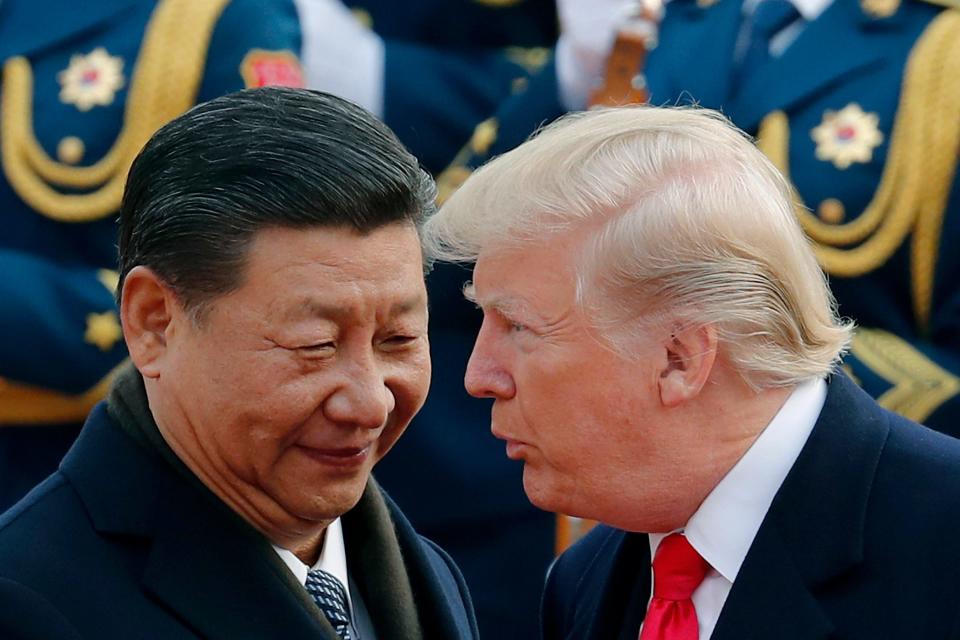Fed stands pat on rates, signals it's prepared to cut if trade war intensifies
WASHINGTON – The Federal Reserve held interest rates steady Wednesday but signaled it's prepared to cut them as soon as next month if the U.S. and China don’t reach a détente in their escalating trade war and other risks continue to grow.
Policymakers also unexpectedly forecast lower rates by next year.
And while the Fed’s median estimate isn’t for a rate cut this year, nearly half of Fed policymakers expect at least one. Eight of the 17 voting Fed policymakers predict as much as a half-percentage-point decline in rates in 2019.
In a statement after a two-day meeting, the Fed highlighted the “uncertainty” of its outlook.
“In light of these uncertainties and muted inflation pressures, the (Fed’s policymaking committee) will closely monitor the implications of incoming information for the economic outlook and will act as appropriate to sustain the expansion, with a strong labor market” and inflation near the Fed’s 2% goal.
That move was expected and echoes Fed Chairman Jerome Powell’s recent vow to support the 10-year-old expansion if the U.S. trade war with China deepens and poses a “downside risk” to its outlook. The Fed also removed its previous vow to be "patient" as it weighs whether to lift or lower rates based on the course the economy takes.
Stocks rose after the Fed announcement, with the Dow Jones industrial average closing up 38 points, or 0.2%, to 26,504 on Wednesday.

For now, the Fed kept its key short-term rate at a range of 2.25% to 2.5% and modestly lowered its economic outlook. A rate cut would mean lower costs for borrowers that have endured higher expenses the past few years but also lower returns for savers who have started to benefit from higher yields.
The trade standoff is the chief reason for the uncertainty, but Powell also cited a sluggish global economy, weak business investment, inflation persistently below the Fed's 2% target and a disappointing 75,000 job gains in May.
"We're monitoring the impact of all these developments," Powell said at a news conference. Citing solid consumer spending, he added, "So far this year, the economy has performed relatively well" and "the baseline outlook is a good one."
But he added, "In the weeks since our last meeting, the crosscurrents have re-emerged. Apparent progress in trade turned into a greater uncertainty. The question is whether these uncertainties will continue to weigh on the outlook."
President Donald Trump has announced plans for a 25% tariff on the remaining $300 billion in Chinese imports not already hit with a duty. The strategy would increase prices for everyday consumer products such as electronics, toys and clothing and ripple through the economy, possibly tipping the nation into recession.
The trade fight has put the Fed in a thorny position because the economy otherwise is slowing but healthy. And Trump is scheduled to meet with Chinese President Xi Jinping at the G-20 summit in Japan this month.
As a result, economists had expected the Fed to walk a fine line Wednesday by signaling that it was ready to lower rates if the G-20 talks don’t head off the latest tariffs but without indicating that a rate cut is a foregone conclusion.
Analysts view such a rate decrease as an unusual “insurance cut” because it would be designed to prevent a potential downturn in the economy that’s not yet evident.
Fed officials may be inclined to act early because a decade after the Great Recession ended, the Fed’s key interest rate is still relatively low. That gives the central bank little room to trim rates to spur growth in case of recession.
Yet the prospect of a rate cut marks a dramatic about-face for a Fed that was lifting rates last year. As recently as December, the Fed had raised rates by a quarter percentage point for a fourth time in 2018 and ninth since late 2015, and forecast two more hikes this year as unemployment hovered near a 50-year low.
What will happen to rates?
The Fed maintained its forecast for stable rates this year, but policymakers are split, with seven projecting a half-percentage-point reduction. Fed officials are also predicting a rate cut in 2020, based on their median estimate.
Officials estimate the benchmark rate will remain at about 2.4% this year but fall to 2.1% by 2020.
Before Wednesday’s Fed statement, fed fund futures markets placed 82% odds on a Fed rate decrease in July. All told, markets are projecting two rate cuts this year and four by the end of 2020.
Economy
The Fed said “economic activity is rising at a moderate rate,” a slight downgrade from its view early last month.
Fed officials kept their forecast for 2.1% growth in 2019 and raised their estimate to a 2% gain next year from their 1.9% projection in March.
The economy generally has been strong, growing at about a 3% pace both last year and in the first quarter. Growth is expected to slow in the second quarter to a still-decent 2% clip and then cool further in the second half of the year as the effects of federal tax cuts and spending increases fade. But an intensifying trade war likely would spell weaker advances.
Jobs
“Job gains have been solid, on average, in recent months, and the unemployment rate has remained low,” the Fed said.
With unemployment at a 50-year low of 3.6%, the Fed lowered its forecast for the jobless rate at the end of this year to 3.6% from 3.7%. It expects the rate to edge up to 3.7% by the end of 2020, below its March estimate of 3.8%.
Average monthly job growth has slowed from 223,000 in 2018 to 164,000 this year, including just 75,000 last month. Analysts cite a moderating economy, as well as the challenges businesses face in finding qualified employees now that the low jobless rate has spawned more worker shortages.
Yet this year’s pace of payroll gains is still about double what’s needed to offset population growth and keep lowering the unemployment rate. Meanwhile, average yearly wage growth has topped 3% since mid-2018 but has edged down in recent months.
Inflation
The Fed acknowledged inflation has remained stubbornly low, giving it room to lower rates., noting one inflation gauge has declined over the past month. The Fed said it expects its preferred measure of annual inflation to stay at 1.5% by year-end before rising to 1.9% in 2020, below its March forecast of 1.8% and 2%, respectively.
It also lowered its estimate of a core reading that strips out volatile food and energy items to 1.8% this year and 1.9% in 2020., down from its March forecasts of 2% for both years
Inflation has remained surprisingly subdued despite a pickup in pay increases that were expected to be passed along to shoppers. Powell has cited temporary factors, such as changes in the way clothing prices are measured.
Many economists, however, point to longer-term trends, such as discounted online shopping. and consumers’ reduced tolerance for price increases.

What it means
Powell and the Fed took pains to walk a fine line by conveying that the economy is still solid but policymakers stand ready to step in with rate cuts if risks such as the trade war with China and slowing global growth loom larger.
Yet officials were more aggressive than expected in their view of rate cuts as soon as this year.
Wells Fargo economist Jay Bryson forecasts a half percentage point rate cut this year, adding he expects uncertainty on trade "to linger." But if Trump and Xi reach a broad deal, "then the need to cut rates may dissipate."
This article originally appeared on USA TODAY: Fed stands pat on rates, signals it's prepared to cut if trade war intensifies
